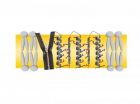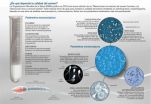(Press-News.org) This press release is available in German.
Membrane proteins are the "molecular machines" in biological cell envelopes. They control diverse processes, such as the transport of molecules across the lipid membrane, signal transduction, and photosynthesis. Their shape, i.e. folding of the molecules, plays a decisive role in the formation of, e.g., pores in the cell membrane. In the Cell magazine, researchers of Karlsruhe Institute of Technology and the University of Cagliari are now reporting a novel charge zipper principle used by proteins to form functional units (DOI: 10.1016/j.cell.2012.12.017).
"It is fascinating to see the elegant basic principles that are used by nature to construct molecular assemblies," explains Anne Ulrich, Director of the KIT Institute for Biological Interfaces. "A charge zipper between the charged side chains is an entirely unexpected mechanism used by membrane proteins to neutralize their charges such that they can be immersed into hydrophobic cell membranes."
In the study published now, Ulrich and her team investigate the so-called Twin-arginine translocase (Tat) that is used in the cell membrane of bacteria as an export machinery for folded proteins. Several TatA subunits assemble as a pore that can adapt its diameter to the size of the cargo to be transported. "But how can such a pore be built up from TatA proteins? How can they reversibly form a huge hole in the membrane for a variety of molecules to pass through, but without causing leakage of the cell?", Ulrich formulates the questions studied.
To answer these questions, the researchers studied the molecular structure of TatA protein from the bacterium B. subtilis, which consists of a chain of 70 amino acids. The analysis showed that it folds into a rather rigid, rod-shaped helix that is followed by a flexible, extended stretch. Many amino acids in the helix and the adjacent stretch carry positive or negative charges. Surprisingly, the sequence of charges on the helix is complementary to those in the adjacent stretch of the protein. When the protein is folded up at the connection point like a pocket knife, positive and negative charges will always meet and attract each other. Hence, the protein links up both of its segments, similar to the interlocking teeth of a zipper.
"The clou is that this binding principle also works with the neighboring proteins," Ulrich says. Instead of folding up alone, every TatA protein also forms charge zippers with both of its neighbors. Computer simulations showed that this leads to stable and, at the same time, flexible connections between the adjacent molecules. In this way, any number of proteins can be linked together to form an uncharged ring, which thus lines the TatA pore in the hydrophobic membrane. This novel charge zipper principle does not only seem to play a role in protein transport, but also in the attack of certain antimicrobial peptides on bacteria, or in their formation of biofilms as a response to stress.
INFORMATION:
More information on the working group: http://www.ibg.kit.edu/nmr/.
Karlsruhe Institute of Technology (KIT) is a public corporation according to the legislation of the state of Baden-Württemberg. It fulfills the mission of a university and the mission of a national research center of the Helmholtz Association. KIT focuses on a knowledge triangle that links the tasks of research, teaching, and innovation.
This press release is available on the internet at www.kit.edu.
The photo of printing quality may be downloaded under www.kit.edu or requested by email or phone. The photo may be used in the context given above exclusively.
Cell: Protein folding via charge zippers
2013-01-18
ELSE PRESS RELEASES FROM THIS DATE:
The cell that isn't
2013-01-18
This may look like yet another video of a dividing cell, but there's a catch. You are looking at chromosomes (red) being pulled apart by the mitotic spindle (green), but it's not a cell, because there's no cell membrane. Like a child sucking an egg out of its shell, Ivo Telley from the European Molecular Biology Laboratory (EMBL) in Heidelberg, Germany, removed these cellular 'innards' from a fruit fly embryo, at a stage when it is essentially a sac full of membrane-less 'cells' that divide and divide without building physical barriers to separate themselves from each other.
"It's ...
Increasing concerns surrounding surrogacy
2013-01-18
COUPLES seeking to build a family, and surrogate mothers overseas who help them, are in danger of emotional, physical and financial exploitation unless UK authorities monitor and regulate the field much more closely, according to a University of Huddersfield professor who has published the results of a detailed investigation.
Eric Blyth – Professor of Social Work at the University of Huddersfield, and based at its Centre for Applied Childhood Studies – is co-author of The changing face of surrogacy in the UK, an article which charts the rapid increase in the numbers of ...
Semen quality of young men in south-east Spain down by 38 percent in the last decade
2013-01-18
The first comparative study on the evolution of sperm quality in young Spanish men over ten years, headed by researchers at the University of Murcia, reveals that spermatozoid concentration in men between 18 and 23 years in the regions of Murcia and Almeria has dropped by an annual average of 2%.
The suspicion that the semen of Spanish men is losing quality now takes force in the case of young men from Murcia and Almeria.
The 'Andrology' journal has published a multidisciplinary and international study, headed by the Department of Preventative Medicine and Public ...
Unrestricted access to the details of deadly eruptions
2013-01-18
Volcanic eruptions have the potential to cause loss of life, disrupt air traffic, impact climate, and significantly alter the surrounding landscape. Knowledge of the past behaviours of volcanoes is key to producing risk assessments of the hazards of modern explosive events.
The open access database of Large Magnitude Explosive Eruptions (LaMEVE) will provide this crucial information to researchers, civil authorities and the general public alike.
Compiled by an international team headed by Dr Sian Crosweller from the Bristol's School of Earth Sciences with support from ...
Breakthrough for solar cell research
2013-01-18
In the latest issue of Science, researchers from Lund University in Sweden have shown how nanowires could pave the way for more efficient and cheaper solar cells.
"Our findings are the first to show that it really is possible to use nanowires to manufacture solar cells", says Magnus Borgström, a researcher in semiconductor physics and the principal author.
Research on solar cell nanowires is on the rise globally. Until now the unattained dream figure was ten per cent efficiency – but now Dr Borgström and his colleagues are able to report an efficiency of 13.8 per cent. ...
Climate change to profoundly affect the Midwest in coming decades
2013-01-18
ANN ARBOR—In the coming decades, climate change will lead to more frequent and more intense Midwest heat waves while degrading air and water quality and threatening public health. Intense rainstorms and floods will become more common, and existing risks to the Great Lakes will be exacerbated.
Those are some of the conclusions contained in the Midwest chapter of a draft report released last week by the federal government that assesses the key impacts of climate change on every region in the country and analyzes its likely effects on human health, water, energy, transportation, ...
ARS scientists test improved stink bug trapping methods
2013-01-18
This press release is available in Spanish.
Baited black traps in a pyramid shape attract significantly more brown marmorated stink bugs than other traps, according to U.S. Department of Agriculture (USDA) scientists. Evaluating stink bug responses to different visual stimuli may help manufacturers design better traps for monitoring the bugs.
Entomologist Tracy Leskey at the Agricultural Research Service (ARS) Appalachian Fruit Research Station in Kearneysville, W.V., focused on visual stimuli that can attract the stink bugs to traps that will help farmers monitor ...
Studying ancient Earth's geochemistry
2013-01-18
Washington, D.C.— Researchers still have much to learn about the volcanism that shaped our planet's early history. New evidence from a team led by Carnegie's Frances Jenner demonstrates that some of the tectonic processes driving volcanic activity, such as those taking place today, were occurring as early as 3.8 billion years ago. Their work is published in Geology.
Upwelling and melting of the Earth's mantle at mid-ocean ridges, as well as the eruption of new magmas on the seafloor, drive the continual production of the oceanic crust. As the oceanic crust moves away ...
Wild animals may contribute to the resurgence of African sleeping sickness
2013-01-18
Wild animals may be a key contributor to the continuing spread of African sleeping sickness, new research published in PLOS Computational Biology shows. The West African form of the disease, also known as Gambiense Human African trypanosomiasis, affects around 10,000 people in Africa every year and is deadly if left untreated.
The disease is caused by a brain-invading parasite transmitted by bites of the tsetse fly, and gets its name from the hallmark symptoms of drowsiness and altered sleeping patterns that affect late-stage patients, along with other physical and neurological ...
Factors linked with survival differences between Black, White kidney failure patients
2013-01-18
Highlights
Residence in areas with higher average household income was linked with improved survival in kidney failure patients.
In White patients, income inequality was associated with mortality.
In Black patients exclusively, residence in highly segregated areas was associated with increased mortality.
More than 590,000 Americans in 2010 were treated for kidney failure.
Washington, DC (January 17, 2013) — Complex socioeconomic and residential factors may account for differences in survival between Black and White kidney failure patients, according to a study ...


